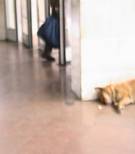

| Home | Our Leadership | Our Economies | Our Wars | Our Perspectives | Our Culture | Links | About |
By Meagan Murphy Ross

As an exchange student at Moscow State University this past spring break, I travelled by subway back and forth between my lodgings and campus. Though it was difficult to get on board during rush time, it was nonetheless one of the most effective modes of public transportation I have experienced. Known as the “Metro,” this subway system is a commons for both the 9 million passengers it transports daily, as well as its 35,000 employees. Pictured above is Novoslobodskaya station, one of 176 stations on the Metro system.
The Metro opened in 1935 and continued construction through WWII. An entire new line opened during the heavy fighting of 1943, and this is now recognized as a propaganda effort to bolster Muscovite spirit during the war. Some of the construction served practical purposes as well: Arbatsko-Pokrovskaya, built during the cold war and completed in 1953, was drilled deeply enough into the earth so that it could act as a shelter in case of nuclear war.
The Metro is a public good utilized by Muscovites on a daily basis. Cooperation is imperative to its survival because of the cost of operation. Everyone needs to buy a ticket for the commons to be a resource that all can use. The cost of using the Metro is affordable to everyone, just over a U.S. dollar, or, locally, less than the cost of a bottle of soda. Historically there has been a discrepancy between operating costs and ticket sales. While under a socialist government this was not an issue, but now, more than ever, it is imperative that all contribute to allow this commons to continue.

The Metro is an integral part of the citizen’s daily life as many people in Moscow do not own a car. In turn, the workers are well-compensated to ensure a strike does not occur. If that were to happen, the city would be in a gridlock. The cost for salaries and expansion means that the ticket prices must be raised incrementally to meet the costs.
Access to the Metro is limited to Muscovites and visitors, which creates a group dynamic. Though there are fewer stations than the London or Paris subway systems, it offers more trips and so serves more people: a train arrives at each station every ten minutes during its operating hours. As Moscow’s suburbia is expanding, so is the track at about 3 miles per year.
On a social and historical level, the architecture of each station reflects the country and its achievements, often quite beautifully, so that the commons passenger has the opportunity to enjoy an esthetically pleasing surrounding while hustling through the stations. Surprisingly, there is no graffiti to be found in the Metro, an indication that this commons is treated with a degree of respect and cooperative responsibility. This commons is monitored through guards and employees; this presence also helps maintain a level of decorum that is not found on the surface streets above.
